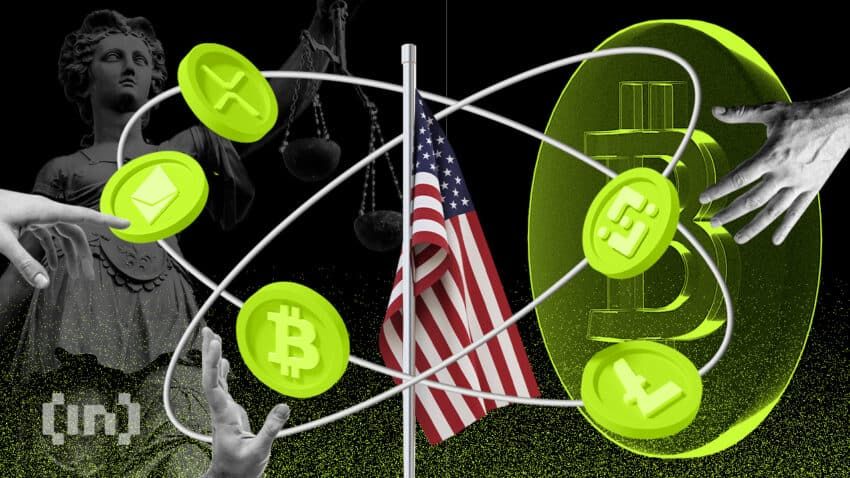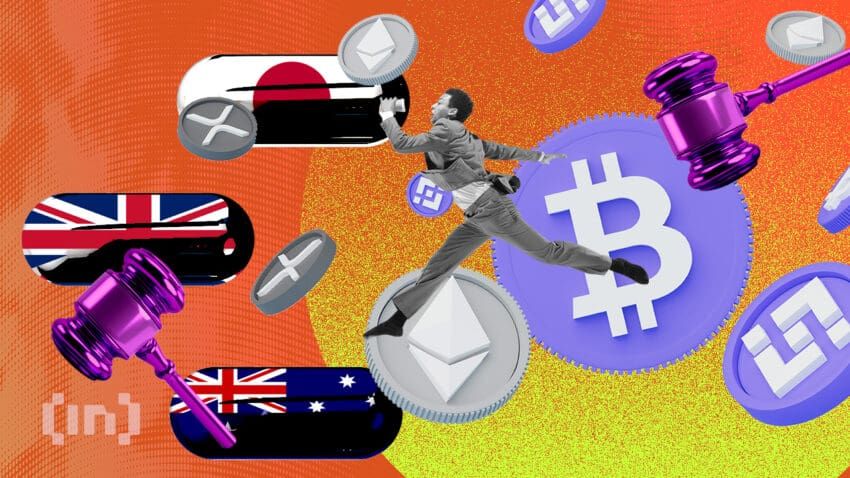As cryptocurrencies have morphed into a new asset class, governments around the world cannot ignore this burgeoning industry. Crypto is playing an increasing role in global finance, and popular exchanges have billions on their balance sheets. Furthermore, last year’s string of black swans, from Terra’s collapse to FTX’s downfall, intensified the pressure for stricter controls. In some form or manner, crypto regulation is on the horizon.
That said, the regulatory landscape is still fragmented. Geographically, cryptocurrencies are subject to various classifications and tax treatment. Some governments regard them as commodities, property, or legal tender, extending TradFi regulations. Others are working on new legislation encompassing decentralized money’s unique aspects and challenges.
This article looks at existing approaches, frameworks in development, and crypto regulation news to present some of the current and foreseeable pros and cons.
Want to get the hottest news of the crypto world? Join BeInCrypto Trading Community on Telegram: read news, discuss crypto projects, ask for technical analysis on coins and get answers to all your questions from PRO traders & experts! Join now
- Crypto vs. fiat money: Differences underlying cryptocurrency laws
- Where is cryptocurrency legal?
- Why bans are not the answer
- Making cryptocurrency legal tender
- US crypto regulations: digital assets as property with new approaches in sight
- Countries where crypto is treated as property
- Canada: Crypto as commodities
- European crypto regulation: Developing a bloc-wide approach
- Caveats of top-down legislation
- Frequently asked questions
Crypto vs. fiat money: Differences underlying cryptocurrency laws

According to the IRS, “digital assets are not real currency (also known as “fiat”) as they are not the coin and paper money of the United States or a foreign country and are not digitally issued by a government’s central bank.”
Here are five key differences between crypto and fiat, defining the need for blockchain regulation:
- No government backing. These digitally created forms of payment function without central banks, deriving value in other ways. For example, the price of Bitcoin is generally determined by market forces and its finite supply.
- Decentralization. Blockchains operate as distributed networks. Instead of centralized oversight, transactions are verified by millions of independent computers – individual nodes – and recorded in immutable ledgers.
- Cross-border transactions. Crypto wallet holders can receive coins and tokens regardless of their physical location. Global reach necessitates international, not only domestic, coordination to “address regulatory gaps and prevent regulatory arbitrage,” as per IMF’s Fintech Notes.
- Superior transparency. All transactions between crypto wallets are recorded publicly and may be traced by anyone via blockchain explorers. Crypto is also pseudonymous – while wallet holders’ identities remain hidden, it may be possible to uncover them through blockchain analytics.
- Immutability. Any transactions on a blockchain, whether legitimate or illicit, are irreversible.
DeFi as a separate set of challenges for cryptocurrency regulation
Crypto market players are not all centralized (CeFi) companies compliant with licensing and AML/KYC/CFT requirements, like the ones for money transmitters. Rapidly growing DeFi (decentralized finance) is radically different – it is based on self-executing contracts, with transactions entirely ruled by code.
Platforms like Aave have no formal management, in stark contrast to CeFi, where firms may operate as financial institutions under local law. The absence of legal entities makes TradFi (traditional finance) law unsuitable for regulating cryptocurrency transactions in DeFi. At present, this industry remains largely unregulated despite its cumulative revenue reaching $4.4. billion last year.
Where is cryptocurrency legal?

At press time, over a hundred countries have passed crypto regulations making digital assets legal. Meanwhile, 42 countries have implicit bans prohibiting local financial institutions from serving crypto companies. However, only nine have imposed blanket crypto bans: Algeria, Bangladesh, China, Egypt, Iraq, Morocco, Nepal, Qatar, and Tunisia.
Why bans are not the answer
Nearly impenetrable and immutable, cryptocurrency transactions are attractive for cybercriminals. Law enforcement has linked various forms of financial crime to crypto globally, including money laundering, tax evasion, and terror financing. As a result, some governments resort to prohibition instead of having cryptocurrency regulated.
Other typical concerns include the carbon footprint. According to the University of Cambridge, Bitcoin miners released nearly 200 million tonnes of carbon dioxide by September 2022, in addition to the emissions from mining Ether and other proof-of-work currencies.
However, outright bans backfire. As China is the world’s second-largest economy, its experience is particularly telling.
China’s experience
Before the ban, China accounted for two-thirds of Bitcoin’s worldwide hash power. With the national economy reliant on coal, the government saw mining as an obstacle to becoming carbon neutral by 2060. Financial crime was another motivation for prohibitive crypto laws — in June 2021, local police arrested over 1,100 people suspected of laundering proceeds from telephone and internet scams through crypto.
China banned Bitcoin mining in May 2021. A few months later, the People’s Bank of China banned all crypto-related activities, citing financial crime concerns and crypto’s speculative nature as a threat to economic stability. This crackdown proved counterproductive for many reasons beyond stifling a promising industry.
Cons outweighing pros
Between 2019 and 2020, over $50 billion worth of crypto flowed abroad from East Asian accounts. The ban hindered capital flight, a risk heightened by debt restructurings at China Evergrande Group — once the country’s biggest developers — and the property industry crisis. It also supported the economic recovery from the pandemic and the drive for “common prosperity.”
Furthermore, the ensuing decline in crypto prices appeared to confirm a close connection with traditional financial markets. This potential risk to national economies is not limited to China — it is also a concern for US regulators. So, what were the downsides?
- Eliminating tax revenue. The ban on mining took over half of the world’s miners offline. Meanwhile, rigs are typically located in underdeveloped and landlocked areas of China with few other tax revenue sources.
- Ineffective mining ban. In May 2022, CNBC reported that the country had become the second-biggest mining hub behind the US. After dropping to zero, the mining capacity recovered due to underground operations. And as crypto enthusiasts found ways to circumvent the ban, production — and carbon emissions — returned.
- Failure to thwart financial crime. In late 2022, the Chinese police arrested 63 people accused of laundering around 12 billion Chinese yuan ($1.7 billion) via crypto since May 2021. The gang allegedly combined multiple methods, including fraud, gambling, and pyramid schemes, and used Telegram to recruit Chinese residents to open crypto accounts for a commission. Thus, despite the crackdown, illicit activities continued.
Making cryptocurrency legal tender

Compared to bans, the opposite extreme is rushing to make crypto legal tender — a legally valid means to settle debts and meet financial obligations — without a solid strategy. Becoming “legally recognized money within a given political jurisdiction” essentially puts regulated cryptocurrency on par with the notes and coins issued by the Federal Reserve.
El Salvador’s experience
In September 2021, El Salvador became the first country to have bitcoins regulated as legal tender. Commenting on the measure, President Nayib Bukele spoke of “financial inclusion, investment, tourism, innovation, and economic development.”
There are many lessons to learn from this bold but hasty adoption. A year later, the cons significantly outweighed the pros, so it is hardly surprising that, so far, only the Central African Republic has followed El Salvador’s example.
High hopes
Among other things, Bukele’s Bitcoin regulations aimed to decouple the national economy from the US dollar and drive adoption. Previously, El Salvador had abandoned the peso and fully “dollarized” its economy by 2000. Thus, the cryptocurrency law diversified the balance of forces in its monetary system.
In countries where the U.S. dollar is the primary currency, there is a dependence on the Federal Reserve’s decisions. Increases in circulating supply, like the ones in 2020, drive inflation without the benefits seen by the US population (for example, stimulus cheques). In late 2021, Bukele even urged the Fed to “stop printing more money.”
Few successes and many failures
So far, Bukele’s crypto law seems to have achieved two goals:
- Making international remittances cheaper. In 2019, despite the user fees reaching 50%, the country received roughly $6 billion in such remittances — almost a fifth of its GDP. As millions of Salvadorans reside abroad, allowing them to pay in BTC was a huge step forward. According to the El Salvador Central Reserve Bank, the volume processed between January and May 2022 approached $52 million.
- Boosting financial inclusion. Around 64% of Salvadorans had no bank account access in 2019, as per Statista. Any resident with internet access can now open a crypto wallet and use global financial market instruments that are less accessible through TradFi.
Yet El Salvador still depends on the US dollar — so far, BTC has failed to hedge it against soaring inflation. Following the 2022 market reversal, most of the regulated crypto purchased by Bukele’s government is underwater. Furthermore, speculative bets are not the only concern.
Problems with Salvador’s adoption
- Vague investments from the national balance sheet. The government does not share the on-chain or off-chain location of those funds. For example, on July 1, 2022, Bukele tweeted, “El Salvador bought today 80 #BTC at $19,000 each!” showing only the amount per transaction.
- Losses from volatility. A week before the tweet, CNBC mentioned “an unrealized paper loss on bitcoin of around $50 million,” equal to less than 0.5% of El Salvador’s budget. Meanwhile, the entire “Bitcoin experiment” may have cost roughly $374 million by that point, a seemingly small amount for an economy of $29 billion but significant considering its obligations.
- Falling credit score. Salvador’s outstanding $800 million bond matures in 2025, and international lenders are less willing to help a country that spends millions on volatile crypto. Making Bitcoin legal tender has prompted Fitch to downgrade El Salvador’s IDR (Long-Term Foreign Currency Issuer Default Rating) due to concerns about its financial future. As a result, borrowing cash became more expensive for El Salvador.
- Technical and logistical failures. Following the rollout, many Salvadorans discovered that identity thieves had stolen their $30 signup bonuses. Users of the state-run Bitcoin wallet Chivo complained about hacks involving identity duplication and draining of funds. Despite the later switch to a more seasoned vendor, the damage to the broader effort was already done.
- Communication failures. The specifics of the Bitcoin regulation were poorly communicated, resulting in rumors of a “forced tender” mandate. In particular, this concerned Article 7, which stated, “Every economic agent must accept bitcoin as payment when offered to him by whoever acquires a good or service.
US crypto regulations: digital assets as property with new approaches in sight

Treating crypto as property is controversial. Gregory Klumov, CEO of Stasis, a platform for tokenizing traditional assets, sees one key reason. Last year, he told FT Advisor, “Global policymakers still have no agreement on how to legislatively segregate utility tokens and payment tokens, especially since one can morph into the other during its lifecycle.”
A 2022 consultation paper by the Law Commission of England and Wales argues that existing property laws cannot fully accommodate digital assets, as the latter has “many different features” and “unique qualities.” Acknowledging these features is a must to “provide a strong legal foundation for the digital assets industry and for users.”
Yet many countries, including the United States, treat crypto as property in the absence of tailored laws. US lawmakers are still discussing federal regulation crypto frameworks. In the meantime, there are differences in cryptocurrency laws by state, and digital assets are treated as property for federal tax purposes. Thus, general principles apply, and residents must report specific “digital asset activity” on their tax returns.
Challenges of taxing crypto
Per the Internal Revenue Service (IRS) Notice 2014-21, any cryptocurrency constitutes property, so profit gained by spending it is taxable. Such crypto transactions are subject to capital gains tax, while income tax applies to activities like mining, staking, and NFT minting.
Users of crypto tax software can skip the hassle of manual filing — such programs automate calculations and generate ready-to-submit reports like IRS Form 8949. However, the range of supported platforms and digital assets varies.
But the IRS guidance overlooks DeFi – it only provides generic rules for all crypto transactions. Crypto tax software providers claim users must pay taxes, as the implications of DeFi and yield farming can still be “inferred.” At the same time, according to PwC, “the characteristics that make DeFi transformative to the future of finance also are features that make it challenging to address from a US tax standpoint.”
Crypto regulation for exchanges
The Financial Crimes Enforcement Network (FinCEN) regards crypto exchanges as money transmitters since crypto tokens are “other value that substitutes for currency.” Like traditional money transmitters, they fall under the scope of the Bank Secrecy Act (BSA). This entails mandatory FinCEN registration, an AML/CFT program, reporting requirements, and compliance with the “Travel Rule” by collecting and sharing data on the originators and beneficiaries of transactions.
Clash of approaches: the SEC vs. the CFTC
To the US Securities and Exchange Commission (SEC), cryptocurrencies are securities, so securities laws should apply to digital wallets and exchanges. Chairman Gary Gensler has famously compared crypto to the Wild West. “Nothing about the crypto markets is incompatible with the securities law,” he said, noting that investor protection was just as relevant for blockchain technology.
However, the Commodities Futures Trading Commission (CFTC) treats Bitcoin as a commodity. It allows public crypto derivatives trading and follows a “do no harm” approach. The outcome of this debate over who regulates cryptocurrency should influence any new crypto regulations in the country.
Reasons to regulate cryptocurrency as securities
The Responsible Financial Innovation Act, introduced in June 2022, treats cryptocurrencies that pass the Howey Test as securities. The test, named after the 1946 US Supreme Court case, includes three questions and requires three positive answers to classify an asset as a security:
1. Is there an investment of money with the expectation of future profits?
2. Is there an investment of money in a common enterprise?
3. Do any profits come from the efforts of a promoter or third party?
If the Act becomes law, issuers must comply with the SEC’s registration and reporting rules or pay substantial penalties for failing to do so. Furthermore, William A. Powers, Nossaman LLP, points to a consensus about treating cryptos as securities when they are bought or sold by members of Congress.
During initial coin offerings, cryptocurrencies are issued similarly to stock. These fundraising endeavors for blockchain and crypto-related firms resemble initial public offerings, or IPOs, in TradFi. Holders of the tokens gain access to the project and its potential profits.
Furthermore, yield farming — a form of the crypto lending market — is comparable to debt securities. Crypto lenders earn interest or fees, similar to share lending in the stock market. This practice allows crypto businesses, such as miners for payment processors, to access lines of credit.
Pros and cons
If the resulting legislation reflects the view of the SEC, crypto regulation will entail more stringent oversight. That said, provided the market passes all the regulatory hurdles, it will attract a wider pool of investors, including those preferring stocks and other conventional publicly traded securities.
Jai Messari, co-founder and CLO of Lightspark and the visiting lecturer at Berkeley Law, recommends the approach from The Ineluctable Modality of Securities Law: Why Fungible Crypto Assets Are Not Securities. According to the paper, buying and selling crypto are not securities transactions, while capital-raising endeavors like ICOs are.
Meanwhile, the SEC’s approach is based on whether the project behind a given crypto asset is “sufficiently decentralized” at any point in time. Messari calls this theory “impractical — if not impossible to apply — in today’s real life blockchain projects.”
Future of US crypto regulations
The Biden administration is now focused on combating illicit transactions, particularly in light of the 2022 Terra collapse and the FTX fiasco, which revealed $5 billion missing from the company’s balance sheet. The Executive Order on Ensuring Responsible Development of Digital Assets outlined the first “whole-of-government” roadmap to crypto legislation. It includes five other priorities:
- Protecting investors and consumers
- Promoting financial stability
- Supporting the country’s financial leadership and economic competitiveness
- Financial inclusion
- Responsible innovation
According to the plan, the US Treasury is due to perform an “illicit finance risk assessment on decentralized finance” by the end of February 2023 and “an assessment on non-fungible tokens by July 2023.” The administration also intends to showcase the country’s leadership in the field of CBDCs (Central Bank Digital Currencies), ensuring any future US government cryptocurrency “is consistent with United States priorities […] and democratic values.”
The crypto community may expect the US authorities to tighten the screws in the coming years. The SEC made the first move in this direction in 2020 when it sued Ripple Labs for allegedly selling the XRP token as an unregistered security.
At press time, a court ruling, potentially crucial for determining if cryptos can be regarded as securities, is expected sometime in 2023.
Countries where crypto is treated as property

Several other countries recognize cryptos as legal property at press time. Thus, their residents may trade, spend, receive, store, and conduct personal and business transactions. Meanwhile, for merchants, accepting cryptocurrencies is voluntary.
Japan. The land of the rising sun has a progressive approach to digital assets with regulations under the Payment Services Act (PSA). In 2020, it established the Japanese Virtual Currency Exchange Association (JVCEA); all crypto exchanges operating in the country are part of it. They are obliged to register with the Financial Services Agency (FSA) and comply with local AML/CFT rules. Meanwhile, trading gains are taxed as “miscellaneous income” at a progressive rate from 5% to 45% plus inhabitant tax to the local government.
Australia. Here, cryptocurrencies are subject to existing laws applicable to conventional property types, including capital gains tax. All exchanges operating in the country must register with the Australian Transaction Reports and Analysis Centre (AUSTRAC) and ensure AML/CTF compliance. According to Cointelegraph, the authorities “have never interfered much with the industry and have embraced the innovation that comes with the technology.”
United Kingdom. As of this writing, the UK authorities consider cryptocurrency as property. All exchanges must register with the UK Financial Conduct Authority (FCA) and comply with specific reporting requirements related to KYC/AML/CFT. Trading profits are subject to capital gains tax. Sales of crypto derivatives to retail customers are banned to prevent “sudden and unexpected losses.”
Note: In October 2022, shortly after Rishi Sunak became prime minister, the House of Commons approved a draft bill (the Financial Services and Markets bill) recognizing cryptocurrencies as regulated financial instruments. However, it may take considerable time to be signed into law — it must pass through the House of Lords before being submitted for royal assent.

Canada: Crypto as commodities
Canadian cryptocurrency regulators have demonstrated a relatively proactive regulatory approach. The local tax authorities equate crypto with commodities, and the country was the first to greenlight a Bitcoin exchange-traded fund. Several such ETFs are trading on the Toronto Stock Exchange.
Registering with provincial authorities is mandatory for all crypto dealers and trading platforms. The Canadian Securities Administrators (CSA) and the Investment Industry Regulatory Organization of Canada (IIROC) provide oversight. Meanwhile, the Financial Transactions and Reports Analysis Centre of Canada (FINTRAC) registers compliant crypto investment firms, treating them as money service businesses (MSBs).
Reasons to regulate cryptocurrency as commodities
Like gold, some cryptocurrencies — for example, Bitcoin — are generally viewed as a store of value. Another aspect both markets share is speculation — betting on significant upward or downward trends to make a profit. This prompts some industry watchers to insist that digital assets must be treated as commodities.
Moreover, due to decentralization — the core principle of blockchain — cryptocurrencies do not produce a return from a common enterprise. As a result, the Howey Test may be interpreted as a basis for such cryptocurrency regulations.
Pros and cons
Commodities are regulated less rigorously than securities, which makes them cheaper to oversee. In addition, price transparency and reporting demands are modest and combined with less stringent market abuse oversight. Thus, this classification may boost investors’ morale, resulting in increased awareness, investment, and acceptance of crypto.
At the same time, using an existing classification leads to the same controversies as applying property laws. This industry is too innovative and disruptive to be fully covered by TradFi regulations. Hence, Western lawmakers are hard at work developing tailored legislation.
European crypto regulation: Developing a bloc-wide approach

Crypto is legal in most of the EU, although member states have different approaches to exchange governance. Generally, crypto businesses must comply with strict KYC/CFT obligations and standard reporting requirements under the Fifth and Sixth Anti-Money Laundering Directives (5AMLD and 6AMLD). Meanwhile, the tax rates vary between 0% and 50%.
The European Commission has proposed a crypto bill unifying the rules for crypto service providers across the bloc. In particular, the Markets in Crypto-Assets Regulation (MiCA) will enhance consumer protections and introduce new licensing requirements. The official press release states, “the EU brings crypto-assets, crypto-assets issuers, and crypto-asset service providers under a regulatory framework for the first time.”
In 2022, the bloc rejected an addition to the bill that would let the EU ban Bitcoin. Two years of debate have gone into this new crypto law, a 400-page document provisionally approved on June 30, 2022. However, parliament has delayed voting twice as of this writing, with the results now expected in April 2023. Importantly, this Europe crypto regulation does not apply to CBDCs (government crypto) or security tokens. These categories are subject to existing EU regulations.
Potential benefits of MiCA as EU crypto regulation
- Clear and unified approach. MiCA will replace a patchwork of regulations across the block with a transparent regulatory environment. For example, it recognizes four types of digital assets — payment tokens, asset-referenced tokens, utility tokens, and e-money tokens — giving clear definitions of each. This clarity should also simplify regional expansion for CASPs (crypto asset service providers) registered in any European Economic Area country.
- Better consumer protection. All centralized platforms must comply with strict requirements to protect customer wallets. They will be held liable for bugs, hacks, and insolvency to guarantee repayments to affected users. In addition, lawmakers will reduce the risk of scams and rug pulls by preventing suspicious businesses from entering the block. Finally, stablecoin issuers will have to maintain protected and liquid reserves that fully back their tokens (1:1).
- Tighter anti-money laundering control. The European Banking Authority will oversee the application of AML laws to the sector and maintain a public register of non-compliant entities. Furthermore, there will be restrictions on foreign organization entry, so crypto firms from countries with a higher risk of money laundering cannot operate in the EU.
- Reducing carbon footprint. Proof-of-work is the most energy-intensive consensus mechanism, as mining requires substantial computing power. Although PoW crypto will remain legal in the EU, MiCA will slash public incentives for this technology and require that companies dealing with such assets regularly submit proof of environmental impact.
Potential drawbacks
- Ignoring DeFi. According to the published draft, regulators are failing to keep up with the crypto market. The DeFi (decentralized finance) industry has grown exponentially in recent years — Axie Infinity alone made a whopping $300 million in revenue in August 2021. The framework also excludes NFTs unless “they fall under existing crypto-asset categories.” However, the European Commission has been tasked with preparing a legislative proposal for NFTs following an in-depth assessment.
- Controversial stablecoin restrictions. The framework includes capping daily transactions at 200 million euros for each stablecoin. Given the role of these assets in DeFi and that the average daily transaction volumes are larger, the new measures may slow crypto adoption.
- No mention of algorithmic stablecoins. MiCA stipulates safeguards for tokens linked to traditional assets but does not mention algorithmic stablecoins — those anchored with mathematical formulas instead of physical reserves. Nor does it mention any regulations for DeFi stablecoins like Dai.
MiCA could be ratified around 2024, so CASPs will have time to adapt to the regime. Its approval may also indicate readiness for the challenge of creating a CBDC for the bloc.
Caveats of top-down legislation
Considering the sheer amount of capital circulating in crypto, governments cannot afford to ban or ignore it. Acknowledging the industry’s inherent differences from TradFi, they are warming up to the challenge of crafting novel legislation addressing its unique benefits and risks. Meanwhile, prominent crypto personalities, including Charles Hoskinson and Andre Cronje, have spoken in support of comprehensive regulation.
The drive for tailored solutions makes two-way communication between financial regulators and crypto players essential. However, this does not always happen. The conventional approach, when legislation is developed and imposed by a centralized authority, has one potential drawback — a potential disconnect from the needs of market participants.
Estonia offers a case in point. A recent change to the Money Laundering and Terrorist Financing Prevention Act in Estonia requires Virtual Assets Service Providers (VASPs) to engage an in-house financial auditor. While Grant Thornton mentions a “small market failure” for auditors, CoinLoan’s Head of Legal Aleksandra Shelepova warns of a compliance deadlock due to the absence of a clear methodology. In her view, one possible solution is allowing crypto firms to operate like self-regulatory organizations (SRO) — a category supervised by FINMA in Switzerland.
The Estonian Auditors’ Association (EAA) elaborated its accountability methods without consulting crypto businesses. “What should have happened is asking a group of active market participants from both sides — audit and crypto — for their input and taking this input into account. While we were asked for our opinion, we feel it has been ignored,” explains Aleksandra.
Worldwide, governments and regulators are hearing objections to equating decentralized money with traditional assets. The White House is seeking public comments on its whole-of-government crypto strategy, and custom-built legislation is in the works in the UK and Europe. However, it remains to be seen whether the lawmakers will accommodate, not merely collect, industry experts’ concerns when shaping new crypto laws.
Frequently asked questions
Where is crypto legal?
How are cryptocurrencies different from the US dollar and other fiat currencies?
How is crypto regulated around the world?
Why did China ban cryptocurrencies?
What is El Salvador’s Bitcoin law?
What is the state of crypto regulation in the US?
What is MiCA and how does it affect the EU crypto market?
Why are regulators developing special laws for digital assets?
About the author

Anna Guseva, a leading writer on the CoinLoan team, has been creating news and research articles for the company since 2021. She is a content writer, editor, and course creator with prior experience in journalism, finance, and the oil industry in Eastern Europe. Before her involvement with CoinLoan, Anna helped dozens of brands and other crypto businesses build a strong online presence through high-quality research. Anna combines extensive knowledge of conventional banking and behavioral economics with a passion for cryptocurrencies and the written word. Her diverse background, insider understanding of CeFi, and curiosity for other dimensions of the crypto economy help her keep an open mind and maintain a focus on objectivity.
Trusted
Disclaimer
In line with the Trust Project guidelines, the educational content on this website is offered in good faith and for general information purposes only. BeInCrypto prioritizes providing high-quality information, taking the time to research and create informative content for readers. While partners may reward the company with commissions for placements in articles, these commissions do not influence the unbiased, honest, and helpful content creation process. Any action taken by the reader based on this information is strictly at their own risk. Please note that our Terms and Conditions, Privacy Policy, and Disclaimers have been updated.




